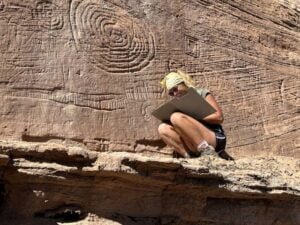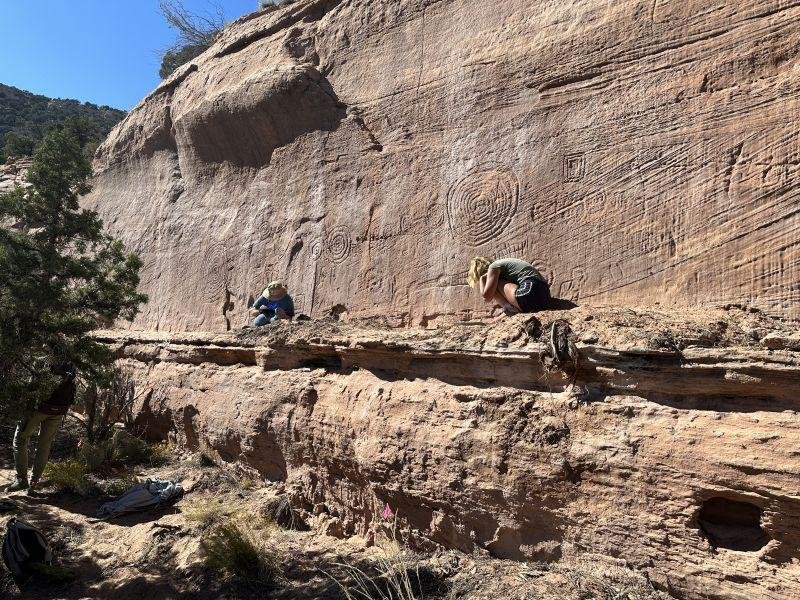Polish archaeologists uncover astronomical petroglyphs dating back to the 3rd century in Colorado
A team of researchers from Jagiellonian University in Kraków, southern Poland, led by Professor Radosław Palonka, has unveiled remarkable findings in the Castle Rock Pueblo settlement complex, situated on the picturesque Mesa Verde plateau along the Colorado-Utah border.
 Credit: Jagiellonian University
Credit: Jagiellonian University
Over a decade of exploration in this region has brought to light extensive petroglyphs and carvings that reshape our understanding of the ancient Pueblo culture that thrived in the area for nearly 3,000 years.
The team’s discoveries, particularly in the higher and less accessible parts of Sand Canyon, Graveyard Canyon, and Rock Creek Canyon, have exceeded expectations, revealing previously unknown petroglyphs dating back to the 3rd century CE, during the Basketmaker Era.
Professor Palonka, a specialist in New World archaeology, expressed the transformative nature of these findings, stating, “These discoveries mean that we have to reconstruct this area anew.”
 The majority of the petroglyphs, originating from the 12th and 13th centuries, display complex geometric figures, spirals, and depictions of shamans, warriors, bison, deer, and hunting scenes.
The majority of the petroglyphs, originating from the 12th and 13th centuries, display complex geometric figures, spirals, and depictions of shamans, warriors, bison, deer, and hunting scenes.
The team also identified carvings from the 15th-17th century, showcasing the influence of the Ute tribe and featuring large narrative hunting scenes that include horses, which were introduced to Native North Americans during the Spanish conquest.
What sets this research apart is the team’s collaboration with local Native American groups such as the Hopi and Ute tribes. Working closely with these communities, the Polish archaeologists aim to decipher the iconography and artistic expressions of the indigenous people. Tribal archaeologist Rebecca Hammond and others have played a crucial role in interpreting rock art and building functions.

Credit: Jagiellonian University
Professor Palonka’s team encountered petroglyphs situated approximately 800 meters above the cliff settlements, featuring spirals up to one meter in diameter. These petroglyphs, used for astronomical observations and marking significant days such as solstices and equinoxes, challenge prior assumptions about the population size and religious practices of the Pueblo community in the 13th century.
To further enhance their research, the Polish archaeologists have collaborated with the University of Houston, known for their expertise in LiDAR technology. The University’s researchers conducted surveys using drones, helicopters, and low-flying planes, creating highly accurate 3D maps of the canyons. Professor Palonka anticipates that this collaboration will lead to the discovery of previously unknown sites from earlier periods.

Credit: Jagiellonian University
The extensive rock panels, stretching up to four kilometers around the mesa plateau, showcase spirals that served both astronomical observations and calendar determinations.
Looking ahead, the Polish team plans to record video interviews with tribal elders for a permanent multimedia exhibit at the Canyons of the Ancients Visitor Center and Museum.
 Pueblo culture settlements. Credit: Jagiellonian University
Pueblo culture settlements. Credit: Jagiellonian University
As Professor Palonka states, “The discoveries dramatically alter the understanding of settlement in the area,” and the ongoing collaboration with international researchers and local Native American communities promises further revelations about the advanced achievements and cultural richness of North America’s indigenous peoples.
Related Post
The entire tomb is filled with signs and symbols that mention Queen Nefertiti and after some time passed and linguistic experts managed to decipher the stories told here, the team was baffled.
The mystery of the Solar Temple of Abu Gurab and its “Star Gate” comes to light
Thuya, the mother of Queen Tiye, left a monumental legacy by becoming the grandmother of Akhenaten and Tutankhamun.
The oldest traditions lead us to believe that blacks were the first inhabitants of Mexico.
The REAL face of King Tut: The pharaoh had feminine hips, clubfoot, and protruding teeth according to the ‘virtual autopsy,’ which also revealed that his parents were brother and sister.
The “oldest gold of humanity” was found in the Varna necropolis, on the Bulgarian Black Sea coast